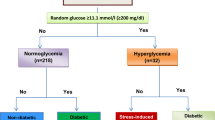Abstract
Purpose
Trauma patients with diabetes mellitus (DM) represent a unique population as the acute injury and the underlying disease may both cause hyperglycemia that leads to poor outcomes. We investigated how insulin-dependent DM (IDDM) and noninsulin-dependent DM (NIDDM) impact mortality after serious trauma without brain injury.
Methods
The National Trauma Data Bank (NTDB) version 7.0 was queried for all patients with moderate to severe traumatic injury [injury severity score (ISS) >9]. Patients were excluded if missing data, age <10 years, severe brain injury [head abbreviated injury scale (AIS) >3], dead on arrival or any AIS = 6. Logistic regression modeled the association between DM and mortality as well as IDDM, NIDDM and mortality.
Results
Overall 166,103 trauma patients without brain injury were analyzed. Mortality was 7.6 and 4.4 % in patients with and without DM, respectively (p < 0.01). Mortality was 9.9 % for patients with IDDM and 6.7 % for NIDDM (p < 0.01). The increased mortality associated with DM was only significantly higher for DM patients in their forties (5.6 vs. 3.3 %, p < 0.01). Regression analyses demonstrated that DM (AOR 1.14, p = 0.04) and IDDM (AOR 1.46, p < 0.01) were predictors of mortality compared to no DM, but NIDDM was not (AOR 1.02, p = 0.83).
Conclusions
While DM was a predictor for higher mortality after serious trauma, this increase was only observed in IDDM and not NIDDM. Our findings suggest IDDM patients who present after serious trauma are unique and attention to their hyperglycemia and related insulin therapy may play a critical role in recovery.
Similar content being viewed by others
References
Overall Numbers, Diabetes and Prediabetes. In: Statistics About Diabetes. American Diabetes Association. 2011. http://www.diabetes.org/diabetes-basics/diabetes-statistics/?loc=DropDownDB-stats. Accessed 6 Dec 2011.
Injury Prevention and Control. In: Injury Center: Overview. Centers for Disease Control and Prevention. 2011. http://www.cdc.gov/injury/overview/. Accessed 6 Dec 2011.
NTDB Annual Report 2011. American College of Surgeons. 2011. http://www.facs.org/trauma/ntdb/pdf/ntdbannualreport2011.pdf. Accessed 6 Dec 2011.
Yendamuri S, Fulda GJ, Tinkoff GH. Admission hyperglycemia as a prognostic indicator in trauma. J Trauma. 2003;55:33–8.
Salim A, Hadjizacharia P, Dubose J, Brown C, Inaba K, Chan LS, et al. Persistent hyperglycemia in severe traumatic brain injury: an independent predictor of outcome. Am Surg. 2009;75:25–9.
Morris JAJ, MacKenzie EJ, Edelstein SL. The effect of preexisting conditions on mortality in trauma patients. JAMA. 1990;263:1942–6.
Ley EJ, Srour MK, Clond MA, Barnajian M, Tillou A, Mirocha J, et al. Diabetic patients with traumatic brain injury: insulin deficiency is associated with increased mortality. J Trauma. 2011;70:1141–4.
Kao LS, Todd SR, Moore FA. The impact of diabetes on outcome in traumatically injured patients: an analysis of the National Trauma Data Bank. Am J Surg. 2006;192:710–4.
Haider AH, Saleem T, Leow JJ, Villegas CV, Kisat M, Schneider EB, et al. Influence of the National Trauma Data Bank on the study of trauma outcomes: is it time to set research best practices to further enhance its impact? J Am Coll Surg. 2012;214:756–68.
Wiener RS, Wiener DC, Larson RJ. Benefits and risks of tight glucose control in critically ill adults: a meta-analysis. JAMA. 2008;300:933–44.
Finfer S, Chittock DR, Su SY-S, Blair D, Foster D, Dhingra V, et al. Intensive versus conventional glucose control in critically ill patients. N Engl J Med. 2009;360:1283–97.
Van den Berghe G, Wouters P, Weekers F, Verwaest C, Bruyninckx F, Schetz M, et al. Intensive insulin therapy in critically ill patients. N Engl J Med. 2001;345:1359–67.
Arabi YM, Dabbagh OC, Tamim HM, Al-Shimemeri AA, Memish ZA, Haddad SH, et al. Intensive versus conventional insulin therapy: a randomized controlled trial in medical and surgical critically ill patients. Crit Care Med. 2008;36:3190–7.
Coester A, Neumann CR, Schmidt MI. Intensive insulin therapy in severe traumatic brain injury: a randomized trial. J Trauma. 2010;68:904–11.
Hunt P, Eardley DD. Suppressive effects of insulin and insulin-like growth factor-1 (IGF1) on immune responses. J Immunol Baltim Md. 1950;1986(136):3994–9.
Dandona P, Aljada A, Mohanty P, Ghanim H, Hamouda W, Assian E, et al. insulin inhibits intranuclear nuclear factor κB and stimulates IκB in mononuclear cells in obese subjects: evidence for an anti-inflammatory effect? J Clin Endocrinol Metab. 2001;86:3257–65.
Aljada A, Ghanim H, Mohanty P, Kapur N, Dandona P. Insulin inhibits the pro-inflammatory transcription factor early growth response gene-1 (Egr)-1 expression in mononuclear cells (MNC) and reduces plasma tissue factor (TF) and plasminogen activator inhibitor-1 (PAI-1) concentrations. J Clin Endocrinol Metab. 2002;87:1419–22.
Demetriades D, Kuncir E, Murray J, Velmahos GC, Rhee P, Chan L. Mortality prediction of head abbreviated injury score and glasgow coma scale: analysis of 7764 head injuries. J Am Coll Surg. 2004;199:216–22.
Demetriades D, Gkiokas G, Velmahos GC, Brown C, Murray J, Noguchi T. Alcohol and illicit drugs in traumatic deaths: prevalence and association with type and severity of injuries. J Am Coll Surg. 2004;199:687–92.
Prins ML, Lee SM, Fujima LS, Hovda DA. Increased cerebral uptake and oxidation of exogenous betaHB improves ATP following traumatic brain injury in adult rats. J Neurochem. 2004;90:666–72.
Author information
Authors and Affiliations
Corresponding author
Ethics declarations
Conflict of interest
Authors Douglas Z Liou, Matthew B Singer, Galinos Barmparas, Megan Y Harada, James Mirocha, Marko Bukur, Ali Salim, and Eric J Ley declare that they have no conflict of interest.
Ethical standard
A database of de-identified patient information was used to conduct this study. This article does not contain any studies with human or animal subjects. The study was approved by the institutional review board at Cedars-Sinai Medical Center.
Rights and permissions
About this article
Cite this article
Liou, D.Z., Singer, M.B., Barmparas, G. et al. Insulin-dependent diabetes and serious trauma. Eur J Trauma Emerg Surg 42, 491–496 (2016). https://doi.org/10.1007/s00068-015-0561-5
Received:
Accepted:
Published:
Issue Date:
DOI: https://doi.org/10.1007/s00068-015-0561-5



